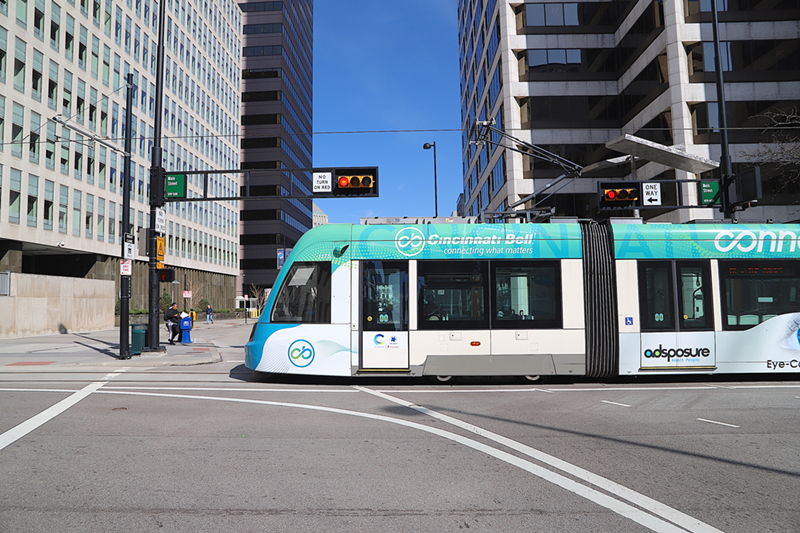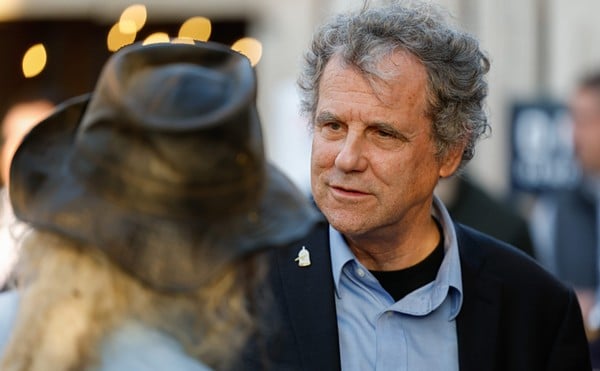Less assumptions about money from a voluntary tax contribution program and more advertising dollars will keep the streetcar going next year, according to officials with the Southwest Ohio Regional Transit Authority, but at the expense of much of the transit project's surplus.
SORTA’s Director of Rail Services Paul Grether and Chief Financial Officer David Riposo today outlined the streetcar's fiscal year 2019 budget for Cincinnati’s streetcar system in a presentation before Cincinnati City Council’s Budget and Finance Committee.
The budget revises down ridership projections, fare receipts and money from a tax program called VTICA after a disappointing year for the transit project, which has been dogged by continued struggles with route obstructions, lagging headways, cold weather mechanical troubles and lower-than-expected ridership numbers. The transit authority forecasts that Cincinnatians and visitors will take 536,291 rides between July 1, 2018 and June 30, 2019, a 73,000 rider dip from projections for this year. With fewer riders come lower fare receipts — SORTA is expecting $406,138 in fare revenue next fiscal year, down from $444,789 this year. All told, revenue for the system is budgeted higher next year at $4,228,357, up from $3,959,454 this year. But expenses will be higher as well.
The spending plan shows a long-term trend: the streetcar will have less and less money in its operating budget over the coming years, according to projections. SORTA entered fiscal year 2018 with $2,018,458 in fund 455, the streetcar’s operating fund from $1.5 million a year the city pays into it from parking revenue. It will end the fiscal year with $1,136,196. After the coming fiscal year, the streetcar's operating fund will dip to $291,977, about $91,000 below the amount needed to meet a requirement that the project keep a cash reserve equal to 10 percent of its revenue. The year after that, it will be roughly $430,000 in the red.
Acting City Manager Patrick Duhaney sent a memo late last month recommending SORTA reduce its FY19 budget by $91,000 or find an equal amount of money in new revenue to close the gap in the streetcar's reserves.
The higher revenue number comes mostly from advertising increases including coming digital kiosks. SORTA this year made big revisions to its expected revenues from Voluntary Tax Incentive Contribution Agreements. Under VTICA, developers agree to contribute a portion of what they would pay on property tax increases for their project to a fund for the streetcar in exchange for a tax break on the rest. SORTA only budgeted about $130,000 from VTICA for fiscal year 2019, much lower than the $400,000 forecast for this year and the more than $500,000 forecast for next.
SORTA based last year’s budget on VTICA forecasts from the city’s Office of Community and Economic Development, Cincinnati Budget Director Chris Bingham says. But those projections were off by a wide margin — the city has only received about $40,000 from the program, causing a need to dip into streetcar reserve funds.
“The primary source where we’re coming up short is VTICA,” Councilman Chris Seelbach said. Seelbach wanted to know why projections were so far off the mark for this fiscal year.
City administration says that’s because the projections were made based on the costs of improvements to properties participating in the program, while the Hamilton County Auditor’s office calculated the contributions based on the actual value of the projects. There has also been a delay in the completion or appraisal of some participating projects.
The budget, already passed by SORTA’s board, comes as Cincinnati City Council mulls a motion by Councilman David Mann that would make the streetcar free to ride. The city also looks to implement a new organizational structure for the rail system championed by Councilman Greg Landsman that will include a CEO tasked with overseeing the transit project. Both proposals are efforts to boost the streetcar’s ridership and performance.
There was some back and forth about Mann's proposal in today’s meeting. There are some potential complications, which would let developers forego parking requirements in exchange for contributions to a fund that would replace the roughly $230,000 SORTA nets from fares.
The city stands to save about $170,000 if it doesn't collect them, including $13,500 a year eliminating fare cards, $22,000 for credit card fees and other savings. That number doesn’t include paying police to inspect fares, which is wrapped up in streetcar manager Transdev’s contract.
But it’s not as simple as unplugging the fare boxes and carting them away. The streetcar was built in part with federal grants, and if it were made free, there would need to be an analysis of implications under federal civil rights laws. Federal law allows for a six-month pilot program while a study of equity issues is conducted, however, meaning the city could start the program while a study was being conducted. It is unclear how much a review of potential equity issues covered by civil rights laws would cost.
SORTA says its budget doesn’t take into account all of the potential angles of Mann’s proposal just yet.
“I don’t want to give the impression that we have a fully-vetted proposal,” Grether said. “We’re having conversations with the administration and are putting the homework together.”
Landsman said he supported the idea, but not before the streetcar gets more reliable. He recounted a cringe-worthy recent incident in which passengers were stuck on a streetcar for almost half an hour as a truck unloaded. Passengers were not allowed to exit the streetcar during that time due to safety concerns, Landsman said.
Eliminating fares before such kinks get ironed out could be counterproductive, he said.
“The Kansas City project is almost identical to ours,” Landsman said. “They are hitting their headways in Kansas City 90 percent of the time. My understanding is we are hitting our headways about 40 percent of the time. Until we get our headways up to 90 percent, which we will, making it free will cause problems.”
In addition to Landsman’s organizational changes for the streetcar, which council approved last week, other council members have suggestions for ways to improve the streetcar’s performance.
Councilman P.G. Sittenfeld wants to adjust the times the streetcar runs, pushing up the project’s 6:30 a.m. start time — when he says no one is riding it — to free up resources to run more cars later in the day. But there’s a problem with that, SORTA officials say — of the five streetcars, only three are available at any given time. One other has been sidelined for repairs since January, and another must be kept in reserve in case an active car breaks down or for maintenance needs.
Sittenfeld also questioned SORTA officials about a statistic they highlighted showing that the streetcar recovers .76 cents for each rider. Fares are one dollar for a one-hour pass or two dollars for an all day pass. Gether says that number, which results from federally-required discounts for elderly people and children as well as people who buy day passes and ride the streetcar multiple times, is up from .73 cents last year. Sittenfeld, however, wanted to know how many riders who don't pay a fare contributed to the stat.
"I'm not blown away by that number," Sittenfeld said, noting that he wants to see an itemized breakdown of discounts, day passes and unpaid fares.






